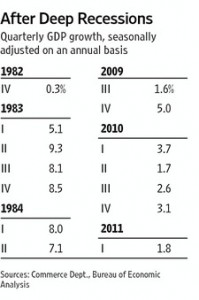Both President Reagan and President Obama had to deal with serious economic dislocation upon taking office.
But they used radically different approaches to deal with the problems they inherited. Reagan sought to reduce the burden of government, whereas Obama viewed government as an engine of growth.
So who had the right approach? This image, taken from an op-ed in today’s Wall Street Journal, shows quarterly economic growth (adjusted for inflation) for the seven quarters after the recession ended.
This image, taken from an op-ed in today’s Wall Street Journal, shows quarterly economic growth (adjusted for inflation) for the seven quarters after the recession ended.
At the risk of sounding unscientific, Reagan mops the floor with Obama. Growth was much more robust under Reaganomics. The policy of Obamanomics, by contrast, is associated with sluggish economic performance. (Indeed, see this post, based on Minneapolis Fed data, for an even starker comparison.)
Most worrisome, the weak growth over the past seven quarters means the economy has not recovered the lost output caused by the recession. This is in contrast to past downturns, where a temporary fall in output was offset by a period of rapid growth when the recession ended. And since there’s no reason to expect a sudden boom now, this means a permanent loss of income for the American people.
To be sure, we have no idea what would have happened in the early 1980s without Reaganomics, just like we have no idea what would have happened the past few years if America had taken a different approach.
But when theory and evidence both point in a certain direction, perhaps it’s a good idea to at least consider the possibility that small government is better for prosperity than big government.

